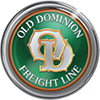Pickup and Delivery vs. Line Haul: Understanding Freight Handling in LTL Shipping
When you partner with Old Dominion, we're dedicated to getting shipments to their destinations on time and damage-free through an extensive LTL network of more than 260 service centers.
OD is committed to safe handling techniques at all points of the shipping process, but there are some key differences in the equipment used to transport freight. But what should customers expect when an OD trailer pulls up to their dock for pickup or delivery?
Arrival at the Dock: The Pickup and Delivery Trailer
Arrival at the Dock: The Pickup and Delivery Trailer
When an LTL trailer backs up to a dock for a delivery or to pick up a shipment, customers might notice additional freight on the trailer floor. These pickups and deliveries are part of the driver's route and will ultimately be transported back to the local service center, where they will be consolidated and dispatched to their destinations.
Pickup and delivery trailers typically range from 28 to 53 feet in length and are designed for easy maneuverability in urban environments to ensure timely deliveries. Some trailers are equipped with lift gates which allows for loading and unloading at locations without a dock.
Upon accepting a shipment, OD takes immediate measures to protect the freight with straps and dunnage before leaving the shipper's dock. This ensures the cargo remains secure as it travels through the driver's daily route before returning to OD's service center.
The OD driver plays a crucial role in the safe and efficient handling of freight and ensures it is loaded and unloaded according to established guidelines to prevent damage. For shippers, consignees, or logistics managers, clear communication with the driver regarding any specific instructions or special handling requirements for a shipment is essential.
In-Transit: The Line Haul Trailer
In-Transit: The Line Haul Trailer
Shipments are transported to their final destinations through OD's extensive LTL network. With more than 260 service centers across the lower 48 states, OD uses its network to provide best-in-class transit times.
OD uses smaller, standardized line haul trailers to transport freight between service centers. These trailers are 28 feet in length, are packed high and tight with freight going to similar destinations, and are carried in tandem with another trailer. You may recognize these trailers on the highway; the double trailers being pulled by an OD tractor. The two tandem trailers allow for 56 feet of trailer space, which is more than the length of a standard 53 foot trailer.
Packing our trailers “high and tight” is a method of loading freight where shipments are stacked vertically (high), placed closely together (tight), and with proper dunnage, maximizing space and ensuring stability.
The use of deck bars that can be adjusted for height is how line haul trailers are neatly packaged and optimized for space.
Shipment Protection Methods
Shipment Protection Methods
- Deck Bars: OD utilizes deck bars to maximize space within a trailer, creating a shelf that optimizes cubic capacity and enhances freight transportation efficiency. This solution not only eliminates the need to stack freight but also ensures the protection of shipments.
- Blocking, Bracing, and Securing Techniques: First and foremost, the goal is to protect shipments for safe transit and minimize the risk of damage. OD dockworkers load trailers by using straps for securement, cardboard and plywood for protection, and airbags to eliminate movement and space inside the trailer.
- OD Technology: The company's load optimization software helps plan the most efficient loading pattern by reducing empty space and improving the load factor. OD also considers loading locations for different freight types and commodities, such as Hazmat and food. This freight technology allows complete visibility into shipments and provides updates on their transit status.
The journey through the OD network relies on line haul trailers, which require meticulous attention to detail, and OD excels in this area. The company's ultra-low claims rate and careful loading techniques provide shippers with confidence when shipping with OD.
Selecting a carrier that prioritizes safe handling throughout the shipping process is an investment in the protection and integrity of freight. With a thorough understanding of the different types of equipment and the secure techniques employed during transport, shippers and logistics managers can ensure the reliability of their operations.
At OD, the commitment to expert handling and advanced technology sets the company apart in the LTL industry, making it a trusted partner for all shipping needs. So next time freight is on the move, customers can rest assured it is in good hands with OD. To learn more about OD's LTL network and our high-quality fleet of equipment, contact your OD Solutions Specialist.
